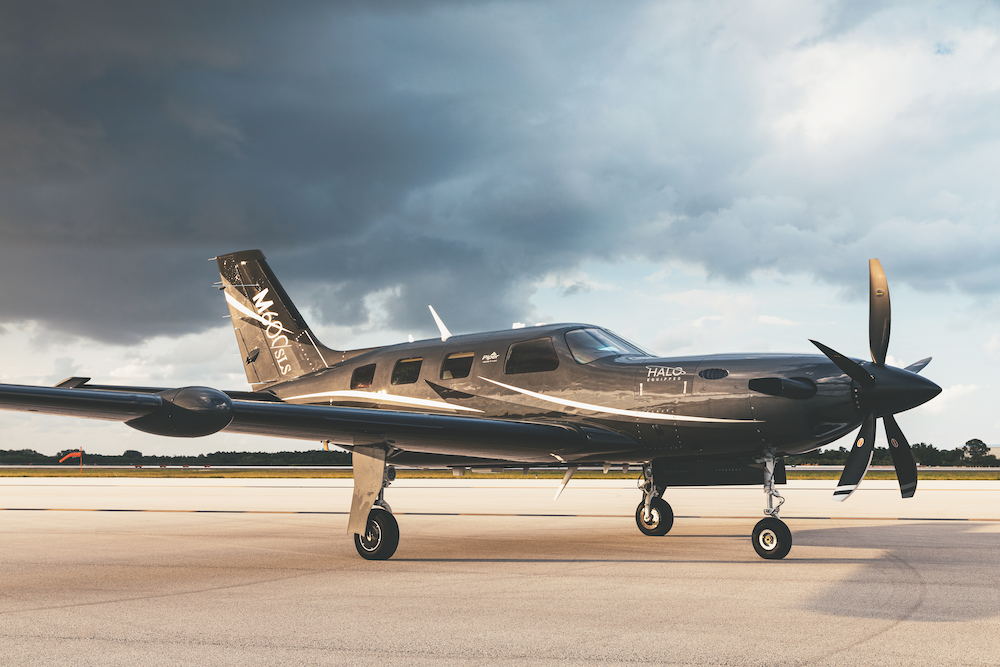Piper M Class Is Ready for SAF, Garmin’s PlaneSync
The manufacturer says the M500, M600, and many Meridian models are now able to use the fuel.

The M600 is ready to use sustainable aviation fuel, as are the M500 and earlier PA-46 Meridian models. [Credit: Jim Barrett]
Remote wakeup is just one of the new tools for pilots on new Piper M600 series turboprops—as well as a significant step forward in the airplane’s sustainable future.
Piper Aircraft announced at AERO 2023 this week in Friedrichshafen, Germany, that the M500, M600, and many Meridian models are now able to use sustainable aviation fuel, as well as Garmin PlaneSync for the G3000 equipped M600/SLS to come in Q2 this year.
The SAF news is welcome, particularly in the current climate in the European Union, where goals to reach net-zero emissions are keenly felt. The series is powered by variations on the Pratt & Whitney PT6 twin-shaft turboprop powerplant, with the PT6A-42A at 600 shp. The FAA blessing—SAIB 56-R4—as well as EASA approval covers SAF nominally using up to a 50/50 blend with traditional jet-A for the moment, as percentages up to that ratio are most widely available.
Ron Gunnarson, Piper’s vice president of sales, marketing, and customer support, characterized it at the press conference, “[The approval of SAF] is for use in every country that the M class can operate, including here [under EASA]. So all jet fuel that meets the requirements of the American Society for Testing and Materials [ASTM] can be used in the Piper PA-46 powered aircraft. The introduction to this will not require a change in any aircraft specifications, and will not require a change in placarding or even in the pilot’s operating handbook.”
The 1:1 Demand Pull
Global economic forces continue to mean Piper is building about as many aircraft as the general aviation market demands, relaxing some from tense highs last year, in which the OEM delivered 236 units—with 70 of those in the M class, including the M350, M500, and M600. M350 demand in particular is going strong—following move ups in the market from Cirrus ST series drivers who see only a small delta between the top of that price range and the $1.6 million for the M350.
“We’re in a pull market for both our trainers and in our M class aircraft—let’s just say it’s not pulling quite as hard as it was maybe a year ago,” said Gunnarson. “That’s not necessarily a bad thing. With 35 years in this business at three different OEMs, I can say that what we were experiencing last year from a production versus supply was unsustainable. I think we’re seeing some of the normalizing, if you will.”
In 2022, Piper delivered 236 aircraft, which was a 14 percent increase over its 2021 figures. Looking ahead, Gunnarson notes that 2023 will continue the trend, as the demand continues and the company’s ability to meet it improves. “For 2023, we’re on track to deliver about 265 aircraft, about 10 percent additional growth, with that same kind of mix. It might be heavier in the M class in 2023. We’ve had strong demand for our M350, the most that we’ve had for several years.
“The dealer pull for the M350 this year was 30-plus aircraft,” Gunnarson added—the most it has seen in recent memory.
Piper shepherds about 70 M class aircraft per year out the door, with 140 in the PA-28 series, which includes the DX, LX, and the Piper 100i.
Garmin PlaneSync
Piper had previewed its latest addition to the Garmin G3000-equipped M600/SLS models—including Garmin PlaneSync—to its customers at the National Business Aviation Association’s convention last fall, and now it’s preparing for the release of the new suite of capabilities for these M-class airplanes using that integrated flight deck.
Updates begin with the addition of enhanced taxi routing via 3D Safe Taxi and preprogramming of taxi clearances. By inputting the cleared route into the GTC touchscreen controller, a routing appears on the multifunction display in a top-down view for increased situational awareness.
The enhancements continue with CAS-based checklists, which will pop up with many corresponding crew alerting system messages, bringing the most likely process to resolve the issue directly to the pilot. Garmin and Piper have also added a glide range ring, stabilized approach annunciations, and additional weight and balance performance features.
Finally, pilots will now have the ability through PlaneSync to remotely “wake up” the airplane and check certain functions and status reports from wherever they have an internet connection. These parameters include database and battery states, and fuel and oil levels. On board the airplane, only the left-hand PFD turns on when the pilot accesses these functions, and only partially so as to conserve battery power.
PlaneSync is anticipated to gain FAA certification in Q2 2023, with EASA and Transport Canada validation to follow.

Subscribe to Our Newsletter
Get the latest FLYING stories delivered directly to your inbox






